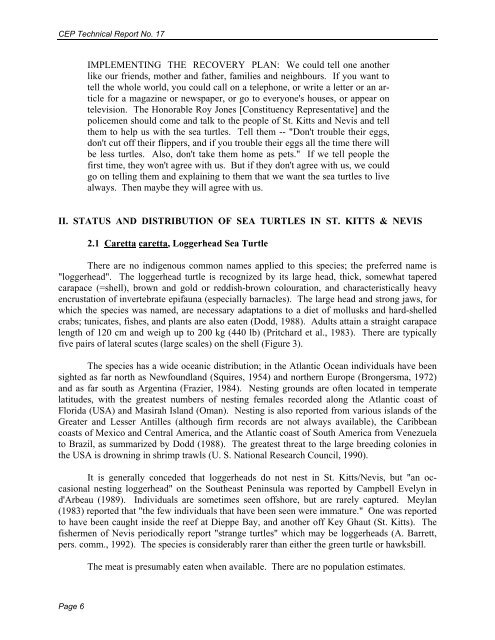Sea Turtle Recovery Action Plan for St. Kitts and Nevis - WIDECAST
Sea Turtle Recovery Action Plan for St. Kitts and Nevis - WIDECAST
Sea Turtle Recovery Action Plan for St. Kitts and Nevis - WIDECAST
You also want an ePaper? Increase the reach of your titles
YUMPU automatically turns print PDFs into web optimized ePapers that Google loves.
CEP Technical Report No. 17<br />
IMPLEMENTING THE RECOVERY PLAN: We could tell one another<br />
like our friends, mother <strong>and</strong> father, families <strong>and</strong> neighbours. If you want to<br />
tell the whole world, you could call on a telephone, or write a letter or an article<br />
<strong>for</strong> a magazine or newspaper, or go to everyone's houses, or appear on<br />
television. The Honorable Roy Jones [Constituency Representative] <strong>and</strong> the<br />
policemen should come <strong>and</strong> talk to the people of <strong>St</strong>. <strong>Kitts</strong> <strong>and</strong> <strong>Nevis</strong> <strong>and</strong> tell<br />
them to help us with the sea turtles. Tell them -- "Don't trouble their eggs,<br />
don't cut off their flippers, <strong>and</strong> if you trouble their eggs all the time there will<br />
be less turtles. Also, don't take them home as pets." If we tell people the<br />
first time, they won't agree with us. But if they don't agree with us, we could<br />
go on telling them <strong>and</strong> explaining to them that we want the sea turtles to live<br />
always. Then maybe they will agree with us.<br />
II. STATUS AND DISTRIBUTION OF SEA TURTLES IN ST. KITTS & NEVIS<br />
2.1 Caretta caretta, Loggerhead <strong>Sea</strong> <strong>Turtle</strong><br />
There are no indigenous common names applied to this species; the preferred name is<br />
"loggerhead". The loggerhead turtle is recognized by its large head, thick, somewhat tapered<br />
carapace (=shell), brown <strong>and</strong> gold or reddish-brown colouration, <strong>and</strong> characteristically heavy<br />
encrustation of invertebrate epifauna (especially barnacles). The large head <strong>and</strong> strong jaws, <strong>for</strong><br />
which the species was named, are necessary adaptations to a diet of mollusks <strong>and</strong> hard-shelled<br />
crabs; tunicates, fishes, <strong>and</strong> plants are also eaten (Dodd, 1988). Adults attain a straight carapace<br />
length of 120 cm <strong>and</strong> weigh up to 200 kg (440 lb) (Pritchard et al., 1983). There are typically<br />
five pairs of lateral scutes (large scales) on the shell (Figure 3).<br />
The species has a wide oceanic distribution; in the Atlantic Ocean individuals have been<br />
sighted as far north as Newfoundl<strong>and</strong> (Squires, 1954) <strong>and</strong> northern Europe (Brongersma, 1972)<br />
<strong>and</strong> as far south as Argentina (Frazier, 1984). Nesting grounds are often located in temperate<br />
latitudes, with the greatest numbers of nesting females recorded along the Atlantic coast of<br />
Florida (USA) <strong>and</strong> Masirah Isl<strong>and</strong> (Oman). Nesting is also reported from various isl<strong>and</strong>s of the<br />
Greater <strong>and</strong> Lesser Antilles (although firm records are not always available), the Caribbean<br />
coasts of Mexico <strong>and</strong> Central America, <strong>and</strong> the Atlantic coast of South America from Venezuela<br />
to Brazil, as summarized by Dodd (1988). The greatest threat to the large breeding colonies in<br />
the USA is drowning in shrimp trawls (U. S. National Research Council, 1990).<br />
It is generally conceded that loggerheads do not nest in <strong>St</strong>. <strong>Kitts</strong>/<strong>Nevis</strong>, but "an occasional<br />
nesting loggerhead" on the Southeast Peninsula was reported by Campbell Evelyn in<br />
d'Arbeau (1989). Individuals are sometimes seen offshore, but are rarely captured. Meylan<br />
(1983) reported that "the few individuals that have been seen were immature." One was reported<br />
to have been caught inside the reef at Dieppe Bay, <strong>and</strong> another off Key Ghaut (<strong>St</strong>. <strong>Kitts</strong>). The<br />
fishermen of <strong>Nevis</strong> periodically report "strange turtles" which may be loggerheads (A. Barrett,<br />
pers. comm., 1992). The species is considerably rarer than either the green turtle or hawksbill.<br />
The meat is presumably eaten when available. There are no population estimates.<br />
Page 6
















